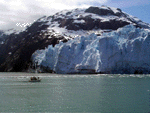The last two days we did a tour of this national park. It's hard to describe this, because half a dozen different aspects would have been individually spell-binding and justified superlatives on their own. With all this together, it's easy to become blase or just lapse into superlative after superlative. So I'm not going to try to be be complete or chronological, but just talk about a few things.
The humpback whales. The encounter starts with a few plumes of water, which shoot perhaps 16 feet straight up, around half a mile away. The boat edges towards them, and as you get closer you see obviously enormous slick black backs sliding out of and then back into the water. It looks for all the world like a giant eel, because the motion is so smooth: there's absolutely no clue that the whale is propelled by flippers or tail. Then, as the last of the body comes by, there's an incredible theatrical finale as the tail flukes (or tail flippers) seem to pause interminably before dipping below the water. It's so majestic, and speaks of such hidden and effortless power, that it's hard to imagine that this isn't a deliberate show.
The sea otters. Sea otters trap air in their fur, and then wrap themselves in kelp. The effect of this is such bouyancy that they float with 80% of their bodies out of the water. They then spend all their time (apparently) lying on their back watching the world go by. Some clutch small stones against which they smash shell fish, others have babies sitting on their stomachs (the babies are such buoyant little furballs that they physically cannot dive!). With their buck teeth, whiskers, and self satisfied little grins, they look like the kind of happily retired gentlemen everyone would like to have on the bench outside their neighbourhood store. Now I know this is hopeless anthropomorphism - a typical day in the real life of a sea otter involves the brutal murder of 40 or more dungeness crabs - but it's really hard to look at one of these things for long without a huge inane grin greeping unconsciously onto your face.
The glaciers. Each one seems to have a unique character. Some carry piles of rubble, others are covered in pristine white snow, still others looks like seas of cruel pointed teeth of ice. The ones in Glacier Bay terminate in the sea, which means they finish in dramatic cliffs against the water's edge. They're beautiful, all shades from pure white to the blue of tropical waters, and strange mystical shapes towering - even at the front faces - hundreds of feet into the air. Compared to the mountain ranges that spawn them, glaciers aren't large, and their lifetimes are mere blinks in geological terms. Yet this dynamism is visible even to humans - the faces are continuously calving (dropping bits into the water) and being replenished - and this makes them much more frightening.
I could go on. The rippling muscles and confidence of bears that know no rivals, the comical gait of tufted puffins, the sure-footed moutain goats and kids, the loafing sea lions, the haughty eagles... You get the idea. Humans put in their place, for once.
P.S. For all the twitchers out there (hi there, Mr. Campbell), here's the complete list (I just wish I knew which of these were rare).
Bald eagles, tufted puffins, gloucous-winged gulls, pelagic cormorants, black oystercatchers, arctic terns, arctic loons, black-legged kittiwakes, pigeon guillemots, and kittlitz's murrelets (spelling?).

Marjore glacier